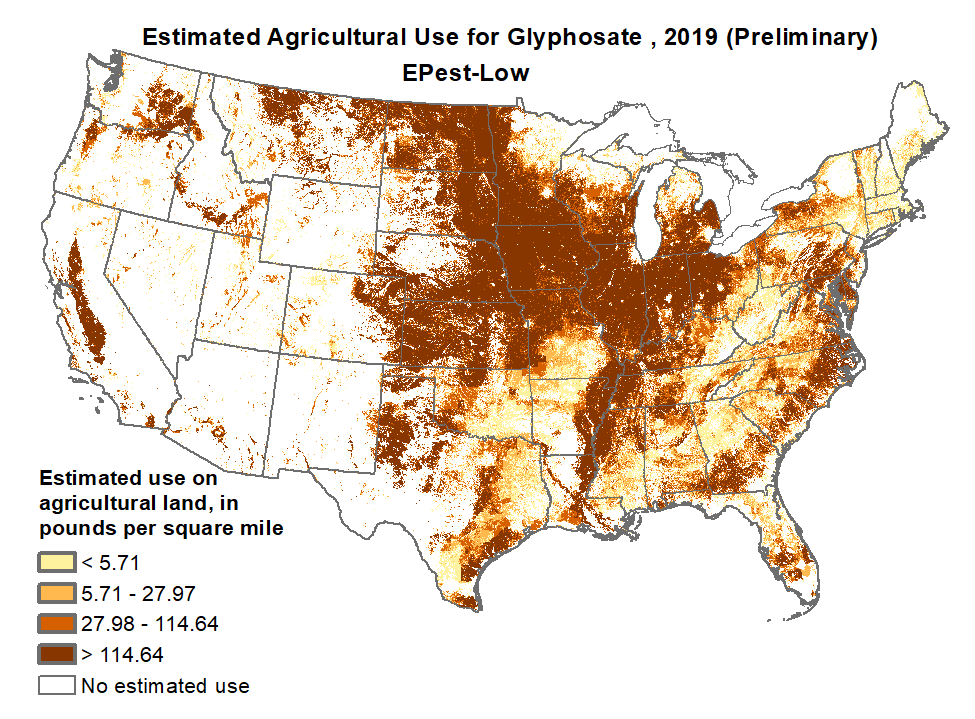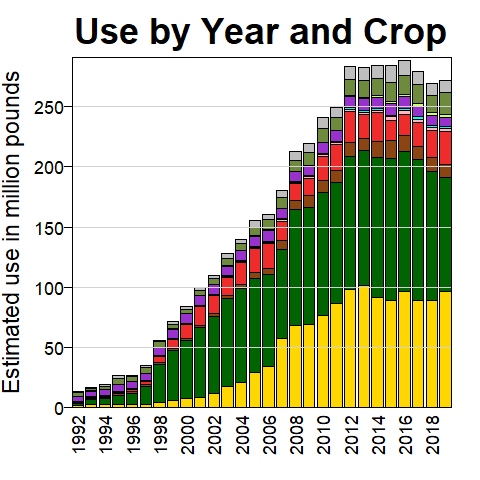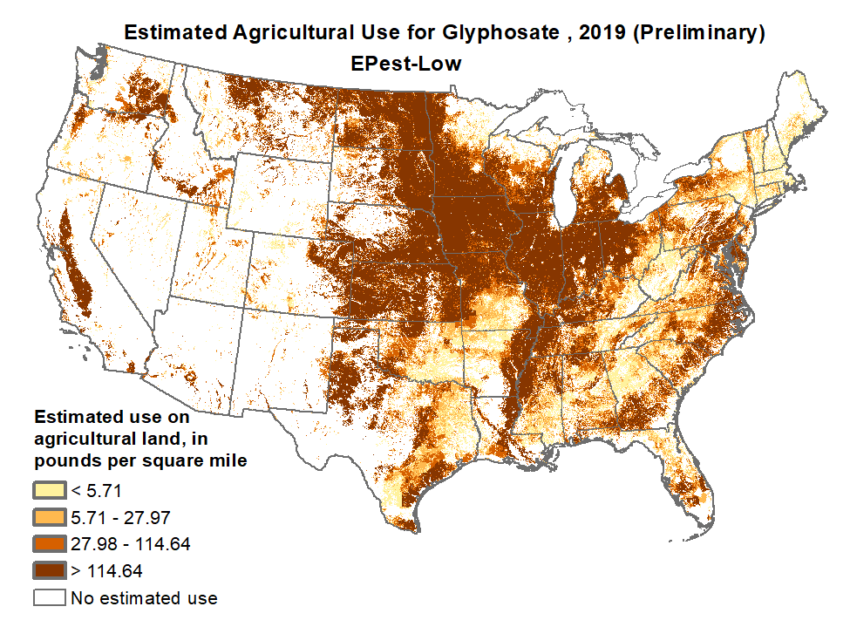Key takeaways:
~ Glyphosate is used at high levels on crops and in urban areas.
~ Most glyphosate passes through the body and is excreted.
~ One study showed an interaction between the negative effects of glyphosate and the CYP1A1 gene variants. Other studies show that glyphosate affects neuronal and oxidative stress pathways.
Members will see their genotype report below, plus additional solutions in the Lifehacks section. Join today.
Glyphosate, detoxification, acetylcholine
RoundUp is the most widely used herbicide in the world. It is made by Monsanto, which Bayer now owns. Glyphosate is the active ingredient in RoundUp, and it will kill most broadleaf plants and grasses.[ref]
Glyphosate works by blocking the shikimate pathway, which is a vital enzyme pathway in plants and some microorganisms. The shikimate pathway is the process by which plants, bacteria, archaea, fungi, and algae make folates and certain amino acids (tryptophan, tyrosine, and phenylalanine). Without those amino acids, plants and microorganisms die.
The shikimate pathway isn’t found in animals, and the amino acids it makes are ones that we must get from our diet (essential amino acids for humans).
Thus, glyphosate, or RoundUp, doesn’t kill animals like it does plants.
Why is RoundUp the most popular kid on the herbicide block? The creation of RoundUp Ready genetically modified crops has increased the use of RoundUp by 100-fold since the 1970s.
These RoundUp Ready crops can be sprayed with glyphosate and not die. Thus, farmers can spray their RoundUp Ready crops, killing all the weeds and leaving their crops standing tall. Roundup Ready crops include soy, corn, canola, alfalfa, cotton, and sugar beets.
The EPA says that ‘there are no risks to public health when glyphosate is used in accordance with its current label and that glyphosate is not a carcinogen’.[ref]
On the other hand, the International Agency for Research on Cancer (IARC) lists glyphosate as a ‘probable carcinogen’, and several recent lawsuits have successfully shown the link between glyphosate exposure and non-Hodgkin’s lymphoma.[ref]
How are we exposed to glyphosate?
Glyphosate is used on many agricultural crops as well as for killing weeds in residential and commercial areas. It is ubiquitous in our environment.
Here is a USGS map showing agricultural use in the US:

Crops that are subjected to glyphosate include:[ref]
- Corn
- Soybeans
- Cotton
- Pastures and Hay (often used for animal feed)
- Wheat
The half-life of glyphosate and AMPA (aminomethylphosphonic acid) in soil range from 2 to 197 days and 76 to 240 days. It was detected in 31% of harvest samples also, but all were below the EPA’s limit.[ref]
Here is how glyphosate usage has grown over the past couple of decades:

Dust in the Wind:
While it is understandable glyphosate is detected on some foods, a recent study surprised me. The researchers sampled vacuum cleaner bags from 60 households, both rural and urban, in France. The results showed that 100% of the household dust contained glyphosate. Higher concentrations were found in rural homes close to agricultural fields and in homes that used weed killers around their driveways and yards.[ref]
Exposure limits:
The European Food Safety Authority sets the Acceptable Daily Intake at 0.5 mg/kg of body weight per day.[ref]
The US EPA classifies glyphosate as “not likely to be carcinogenic to humans”, however, the WHO (World Health Organization) classifies glyphosate as “probably carcinogenic to humans.”[ref]
Which foods often contain glyphosate?[ref]
- Honeybees visit agriculture fields and bring glyphosate back to the hive with them. Thus, the amount of glyphosate in honey is going to reflect how much is being used in the surrounding agricultural fields. One study showed 28% of US honey samples contained glyphosate, while another found that 98% of Canadian honey samples contained glyphosate.
- A European study found that glyphosate was not detected in any of the olive oil samples.
- Cereals and cereal grain products (wheat products, corn, snacks, bread) often contain glyphosate, with detection frequency varying from country to country.
- Fruits tend not to have much glyphosate contamination on them.
Glyphosate is not allowed on certified organic foods.
A recent study in the UK found glyphosate in the urine of 53% of study participants.[ref] Studies in the US find glyphosate in the urine of 60-80% of the population.[ref]
Glyphosate Metabolism:
Animal studies show the absorption of glyphosate is ~30-36% when ingested. Absorption through the skin, though, is really low (~2% over 8 hours).[ref]
Most of the glyphosate you eat will be excreted in feces or urine. A small percentage of it is metabolized or broken down into aminomethylphosphonic acid (AMPA).[ref]
So if glyphosate mostly just passes on through, why worry about it?
The impact on the gut microbiome:
As I mentioned above, glyphosate’s mechanism of action blocks the shikimate pathway, which bacteria, archaea, fungi, and plants use to create folates and certain amino acids.
The real question here is one of gut health: what is glyphosate doing to the bacteria, archaea, and fungi that make up our gut microbiome?
A recently published study found that about one-half of the human microbiota is sensitive to glyphosate. Firmicutes were more resistant, while Proteobacteria and Actinobacteria were more sensitive to glyphosate.[ref]
Researchers have found that certain strains of Clostridium and Salmonella are resistant to glyphosate. This may cause an increase or overgrowth of these bacterial species in the gut microbiome.[ref]
Keep in mind that we rely on the gut microbiome to produce part of our essential vitamins. For example, riboflavin and niacin are produced by Proteobacteria. Several different families of bacteria also make folate in the gut.[ref]
Part of the difficulty in determining whether glyphosate is causing changes to the gut microbiome is that we all have various different pesticides in our guts, along with different genetic interactions that influence our microbiome. So teasing out the differences in how glyphosate really impacts the microbiome is confounded by many different variables.[ref] The real-life human impact on a daily basis is not as simple as the animal studies indicate.
Genetics and glyphosate: Impact on human health?
A study was published in 2020 showing that some people are likely more affected by exposure to glyphosate than others.[ref]
The study found that people with CYP1A1 genetic variants were more likely to have problems with cholinesterase inhibition from glyphosate.
Let me explain what cholinesterase inhibition means…
Glyphosate has been shown in animal studies to affect acetylcholinesterase – a little bit. Acetylcholinesterase is the enzyme that breaks down acetylcholine, which is a completely essential neurotransmitter.
Acetylcholine transfers the signal between the nerves that control your muscles (and also neurons in the brain). Think of it as the on switch for a muscle nerve that causes a contraction. For every ‘on’ impulse, you need to stop the signal with an ‘off switch’ — that would be acetylcholinesterase.
Prior animal studies showed that glyphosate inhibits acetylcholinesterase (a little).[ref][ref]
If you inhibit acetylcholinesterase too much, it leads to paralysis, convulsions, and death due to asphyxiation (not being able to move the muscles around the lungs to breathe). This is how nerve gas, such as Sarin gas, works in chemical warfare. Not pretty… but also nothing like the very low levels that we are talking about here.
Serum cholinesterase is used as a marker of herbicide poisoning because levels decrease when liver function is damaged.[ref]
Getting back to glyphosate and how it affects people…
A recent study was done on people whose job it was to make glyphosate in China. The workers were exposed only to glyphosate and not to pesticides, thus reducing the confounders seen in studies on agricultural workers. The glyphosate manufacturing workers had blood tests done to determine what their serum acetylcholinesterase levels were.[ref]
The study showed that people with a specific CYP1A1 variant (listed below) had significantly lower acetylcholinesterase levels due to glyphosate exposure. This variant alters CYP1A1 expression. Lower acetylcholinesterase was assumed to be a marker of liver damage.
CYP1A1 is a member of the cytochrome P450 group of enzymes. It metabolizes or breaks down many different compounds, such as polycyclic aromatic hydrocarbons (PAHs), paracetamol, caffeine, and nicotine. Once compounds are metabolized using the CYP enzymes, they can be more easily eliminated from the body.
A couple of takeaways from this study:
First, there is an effect of glyphosate on acetylcholinesterase levels, especially at higher exposure levels. Most of the EPA information says that glyphosate passes through people without being metabolized — which apparently isn’t accurate for everyone.
Second, the urinary glyphosate metabolite levels of these Chinese glyphosate manufacturer workers were not all that high. A recent study of children in Mexico showed similar average concentrations to that of the Chinese glyphosate manufacturing workers.[ref]
Other recent studies on glyphosate detoxification:
Another recent cell study found that glyphosate and the glyphosate metabolite aminomethylphosphonic acid (AMPA) altered gene expression, indicating that either the metabolite AMPA or glyphosate was affecting cells. Pathways impacted include tumor necrosis factor alpha (TNF⍺), TP53, NF-kB, and more in the pathways involving apoptosis, oxidative stress, and cell death.[ref]
Another study, in rats, found that glyphosate exposure at levels that caused no observable signs of dysfunction did change serotonin, dopamine, and norepinephrine levels in the brain.[ref]
Several studies have shown that glyphosate increases TNF-alpha, which is an inflammatory cytokine.[ref][ref] For example, a study in mice found that exposure to glyphosate infiltrated the brain and elevated TNF levels both in the brain and in the plasma.[ref]
In the intestines, glyphosate has been shown in animal studies (pigs) to increase Nrf2 levels, inducing NF-kB.[ref] Nuclear factor-κB (NF-κB) signals for danger and induces an innate immune response. [ref]
Glyphosate Detoxification Genotype Report:
Not a member? Join Here.
Membership lets you see your data right in each article and also gives you access to the members’ only information in the Lifehacks sections.
CYP1A1 Gene:
Check your genetic data for rs1048943 A2455G (23andMe v4 only):
- T/T: typical
- C/T: carrier of one CYP1A1*2 allele; smokers have a higher risk of lung cancers; higher activity in estrogen metabolism; more likely to have low acetylcholinesterase due to glyphosate exposure, especially in women
- C/C: CYP1A1*2; higher risk of oral cancer & lung cancers in smokers; higher activity in estrogen metabolism[ref][ref][ref]; more likely to have low acetylcholinesterase due to glyphosate exposure, especially in women[ref]
Members: Your genotype for rs1048943 is —.
Lifehacks:
First, I will cover a few ways to mitigate glyphosate exposure to some extent. Realistically, I don’t know that most people can avoid it altogether.
Next, I will go into some more speculative ways that glyphosate could interact with your genes and gut microbiome.
The rest of this article is for Genetic Lifehacks members only. Consider joining today to see the rest of this article.
Avoiding Glyphosate:
Member Content:
An active subscription is required to access this content.
Join Here for full access to this article, genotype reports, and much more!
Already a member? Log in below.
Related Articles and Topics:
Detoxifying Organophosphates:
Pesticides that are sprayed on conventionally grown foods affect people differently. Some people carry genetic variants that decrease their ability to detoxify specific pesticides, and others may be more resilient.
BPA: Genetics and Detoxification
Ubiquitous in our environment, BPA is an endocrine-disrupting chemical. Some people are genetically at a disadvantage in detoxifying BPA.
TNF alpha: Inflammation, Genetics, and Natural Inhibitors
Do you feel like you are constantly dealing with inflammation? Joint pain, food sensitivity, etc.? Perhaps you are genetically geared towards a higher inflammatory response. Tumor necrosis factor (TNF) is an inflammatory cytokine that acts as a signaling molecule in our immune system.
Understanding the Connection Between Alcohol & Histamine Intolerance
Drinking alcohol is often a problem for people with histamine intolerance. Learn about the pathways that are involved and how to avoid alcohol-induced reactions.
References:
2019 Pesticide Use Maps -. https://water.usgs.gov/nawqa/pnsp/usage/maps/show_map.php?year=2019&map=GLYPHOSATE&hilo=L. Accessed 10 Jan. 2023.
Albensi, Benedict C. “What Is Nuclear Factor Kappa B (NF-ΚB) Doing in and to the Mitochondrion?” Frontiers in Cell and Developmental Biology, vol. 7, 2019. Frontiers, https://www.frontiersin.org/articles/10.3389/fcell.2019.00154.
Baier, Carlos Javier, et al. “Behavioral Impairments Following Repeated Intranasal Glyphosate-Based Herbicide Administration in Mice.” Neurotoxicology and Teratology, vol. 64, Nov. 2017, pp. 63–72. ScienceDirect, https://doi.org/10.1016/j.ntt.2017.10.004.
Battaglin, William A., et al. “GLYPHOSATE, OTHER HERBICIDES, AND TRANSFORMATION PRODUCTS IN MIDWESTERN STREAMS, 20021.” Journal of the American Water Resources Association, vol. 41, no. 2, Apr. 2005, pp. 323–32. DOI.org (Crossref), https://doi.org/10.1111/j.1752-1688.2005.tb03738.x.
Benbrook, Charles M. “Trends in Glyphosate Herbicide Use in the United States and Globally.” Environmental Sciences Europe, vol. 28, no. 1, 2016, p. 3. PubMed Central, https://doi.org/10.1186/s12302-016-0070-0.
Cai, Wenyan, et al. “Correlation between CYP1A1 Polymorphisms and Susceptibility to Glyphosate-Induced Reduction of Serum Cholinesterase: A Case-Control Study of a Chinese Population.” Pesticide Biochemistry and Physiology, vol. 162, Jan. 2020, pp. 23–28. ScienceDirect, https://doi.org/10.1016/j.pestbp.2019.07.006.
Chiarello, Marilda, et al. “Fast Analysis of Glufosinate, Glyphosate and Its Main Metabolite, Aminomethylphosphonic Acid, in Edible Oils, by Liquid Chromatographycoupled with Electrospray Tandem Mass Spectrometry.” Food Additives & Contaminants. Part A, Chemistry, Analysis, Control, Exposure & Risk Assessment, vol. 36, no. 9, Sept. 2019, pp. 1376–84. PubMed, https://doi.org/10.1080/19440049.2019.1631493.
Costas-Ferreira, Carmen, et al. “Toxic Effects of Glyphosate on the Nervous System: A Systematic Review.” International Journal of Molecular Sciences, vol. 23, no. 9, Apr. 2022, p. 4605. PubMed Central, https://doi.org/10.3390/ijms23094605.
El-Shenawy, Nahla S. “Oxidative Stress Responses of Rats Exposed to Roundup and Its Active Ingredient Glyphosate.” Environmental Toxicology and Pharmacology, vol. 28, no. 3, Nov. 2009, pp. 379–85. ScienceDirect, https://doi.org/10.1016/j.etap.2009.06.001.
Glyphosate Technical Fact Sheet. http://npic.orst.edu/factsheets/archive/glyphotech.html. Accessed 10 Jan. 2023.
Gunatilake, Sarath, et al. “Glyphosate’s Synergistic Toxicity in Combination with Other Factors as a Cause of Chronic Kidney Disease of Unknown Origin.” International Journal of Environmental Research and Public Health, vol. 16, no. 15, Aug. 2019, p. 2734. PubMed Central, https://doi.org/10.3390/ijerph16152734.
Hossain, Khandkar Shaharina, et al. “B Vitamins and Their Roles in Gut Health.” Microorganisms, vol. 10, no. 6, June 2022, p. 1168. PubMed Central, https://doi.org/10.3390/microorganisms10061168.
Larsen, Karen E., et al. “The Herbicide Glyphosate Is a Weak Inhibitor of Acetylcholinesterase in Rats.” Environmental Toxicology and Pharmacology, vol. 45, July 2016, pp. 41–44. ScienceDirect, https://doi.org/10.1016/j.etap.2016.05.012.
Martínez, María-Aránzazu, Irma Ares, et al. “Neurotransmitter Changes in Rat Brain Regions Following Glyphosate Exposure.” Environmental Research, vol. 161, Feb. 2018, pp. 212–19. ScienceDirect, https://doi.org/10.1016/j.envres.2017.10.051.
Martínez, María-Aránzazu, José-Luis Rodríguez, et al. “Use of Human Neuroblastoma SH-SY5Y Cells to Evaluate Glyphosate-Induced Effects on Oxidative Stress, Neuronal Development and Cell Death Signaling Pathways.” Environment International, vol. 135, Feb. 2020, p. 105414. PubMed, https://doi.org/10.1016/j.envint.2019.105414.
Masood, Muhammad Irfan, et al. “Environment Permissible Concentrations of Glyphosate in Drinking Water Can Influence the Fate of Neural Stem Cells from the Subventricular Zone of the Postnatal Mouse.” Environmental Pollution (Barking, Essex: 1987), vol. 270, Feb. 2021, p. 116179. PubMed, https://doi.org/10.1016/j.envpol.2020.116179.
Mesnage, Robin, et al. “Impacts of Dietary Exposure to Pesticides on Faecal Microbiome Metabolism in Adult Twins.” Environmental Health, vol. 21, May 2022, p. 46. PubMed Central, https://doi.org/10.1186/s12940-022-00860-0.
Puigbò, Pere, et al. “Does Glyphosate Affect the Human Microbiota?” Life, vol. 12, no. 5, May 2022, p. 707. PubMed Central, https://doi.org/10.3390/life12050707.
Qiu, Shengnan, et al. “Toxic Effects of Glyphosate on Intestinal Morphology, Antioxidant Capacity and Barrier Function in Weaned Piglets.” Ecotoxicology and Environmental Safety, vol. 187, Jan. 2020, p. 109846. PubMed, https://doi.org/10.1016/j.ecoenv.2019.109846.
Rueda-Ruzafa, Lola, et al. “Gut Microbiota and Neurological Effects of Glyphosate.” Neurotoxicology, vol. 75, Dec. 2019, pp. 1–8. PubMed, https://doi.org/10.1016/j.neuro.2019.08.006.
Saurat, Dominique, et al. “Determination of Glyphosate and AMPA in Indoor Settled Dust by Hydrophilic Interaction Liquid Chromatography with Tandem Mass Spectrometry and Implications for Human Exposure.” Journal of Hazardous Materials, vol. 446, Dec. 2022, p. 130654. PubMed, https://doi.org/10.1016/j.jhazmat.2022.130654.
Schwarz, Dieter, et al. “Inhibition of 17β-Estradiol Activation by CYP1A1: Genotype- and Regioselective Inhibition by St. John’s Wort and Several Natural Polyphenols.” Biochimica Et Biophysica Acta, vol. 1814, no. 1, Jan. 2011, pp. 168–74. PubMed, https://doi.org/10.1016/j.bbapap.2010.09.014.
Sierra-Diaz, Erick, et al. “Urinary Pesticide Levels in Children and Adolescents Residing in Two Agricultural Communities in Mexico.” International Journal of Environmental Research and Public Health, vol. 16, no. 4, Feb. 2019, p. 562. PubMed Central, https://doi.org/10.3390/ijerph16040562.
Soares, Diogo, et al. “Glyphosate Use, Toxicity and Occurrence in Food.” Foods, vol. 10, no. 11, Nov. 2021, p. 2785. PubMed Central, https://doi.org/10.3390/foods10112785.
StackPath. https://toxinfreeusa.org/food-testing/eating-out-a-date-with-glyphosate/. Accessed 10 Jan. 2023.
US EPA, OCSPP. Glyphosate. 18 Sept. 2014, https://www.epa.gov/ingredients-used-pesticide-products/glyphosate.
Winstone, Joanna K., et al. “Glyphosate Infiltrates the Brain and Increases Pro-Inflammatory Cytokine TNFα: Implications for Neurodegenerative Disorders.” Journal of Neuroinflammation, vol. 19, July 2022, p. 193. PubMed Central, https://doi.org/10.1186/s12974-022-02544-5.
Yang, Xiao-Lei, et al. “Association between CYP1A1 Ile462Val Polymorphism and Oral Squamous Cell Carcinoma Susceptibility: Evidence from 13 Investigations.” Journal of Cancer, vol. 6, no. 4, 2015, pp. 302–09. PubMed, https://doi.org/10.7150/jca.11036.
Yu, Kai-Tao, et al. “CYP1A1 Polymorphism Interactions with Smoking Status in Oral Cancer Risk: Evidence from Epidemiological Studies.” Tumour Biology: The Journal of the International Society for Oncodevelopmental Biology and Medicine, vol. 35, no. 11, Nov. 2014, pp. 11183–91. PubMed, https://doi.org/10.1007/s13277-014-2422-y.
Zamaratskaia, Galia, et al. “Co-Treatment with Indole-3-Carbinol and Resveratrol Modify Porcine CYP1A and CYP3A Activities and Expression.” Xenobiotica; the Fate of Foreign Compounds in Biological Systems, vol. 48, no. 3, Mar. 2018, pp. 232–40. PubMed, https://doi.org/10.1080/00498254.2017.1300708.


Your point of view caught my eye and was very interesting. Thanks. I have a question for you. https://www.binance.com/zh-TC/join?ref=S5H7X3LP